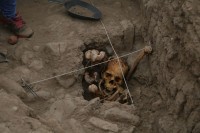 The remains of four mummies of the pre-Inca Ychsma people have been unearthed in the Huaca Pucllana temple in the Miraflores neighborhood of Lima, Peru. All of the mummies are of adults, three women, one man, buried in a seated posture. They were originally mummy bundles, wrapped in layers of textiles, straw and ropes then covered with mats. Today they are very decomposed, almost entirely skeletonized, with few of their organic grave goods extant. Next to them were found ceramic pots, mate’ drinking vessels and objects related to textile production (needles, yarn, woven fabric and more).
The remains of four mummies of the pre-Inca Ychsma people have been unearthed in the Huaca Pucllana temple in the Miraflores neighborhood of Lima, Peru. All of the mummies are of adults, three women, one man, buried in a seated posture. They were originally mummy bundles, wrapped in layers of textiles, straw and ropes then covered with mats. Today they are very decomposed, almost entirely skeletonized, with few of their organic grave goods extant. Next to them were found ceramic pots, mate’ drinking vessels and objects related to textile production (needles, yarn, woven fabric and more).
They were found at the top of the Great Pyramid, an impressive structure made of adobe and clay brick by the Lima culture between 200 and 650 A.D. as a religious and administrative center. Its bookshelf style construction in which bricks were placed side by side like books on a shelf with the outer ones leaning in made it earthquake resistant and when the Wari Empire took over the area in around 650 A.D., they continued to use the pyramid, burying their important dignitaries within its walls. Now it appears the Ychsma did the same.
Earlier evidence of Ychsma activity at the Great Pyramid was discovered in 1967 when offerings of anthropomorphic figurines were found at the foot of the western slop of the pyramid. A follow-up excavation revealed that the spot was used by the Ychsma to dry their crops. As farmers and weavers, they would leave offerings of their most significant products: packets of cotton and food jars filled with beans and maize. The discovery of burials at the top of the pyramid suggests stronger presence of the Ychsma in the area that would become Miraflores.
“Our hypothesis is that they were involved in politics, religion or of high status,” said archaeologist Mirella Ganoza. “This site was not chosen at random.”
Isabel Flores, director of the Museum of Site of Huaca Pucllana, notes that we may discover more about the remains and burial practices of the Ychsma when the remains are analyzed. The exact date of the burials will also hopefully be revealed by radiocarbon dating. The only date range we have now is 1000 to 1450 A.D., the known range of Ychsma presence in the area.
Before the city of Lima was founded by conquistador Francisco Pizarro in 1535, it was a river valley populated by the Ychsma people who were one of two cultures who came to dominate central coastal Peru after the collapse of the Wari Empire around 1000 A.D. The Ychsma developed the Rímac and Lurín river valleys, modifying old Wari temples and building new ones of their own. When the area was conquered by the Inca under Emperor Túpac Inca Yupanqui in 1470, the Ychsma were absorbed into the Inca Empire and ceased to exist as a separate political and cultural group.
I’ve often wondered what it would have been like to live in a great imperial city in the pre-Columbian Americas. Even to spend a day in Tenōchtitlan, for instance, would be a life-changer. Considering this, it’s possible to grasp – for a moment, within a tiny fraction – what it must have been like when Spaniards and Americans met half a millennium ago.
Thanks for sharing such a story! Everything about this discovery and its situation speak civilization and wonder. Let’s hope they go on speaking through these fabulous archaologists and scholars.